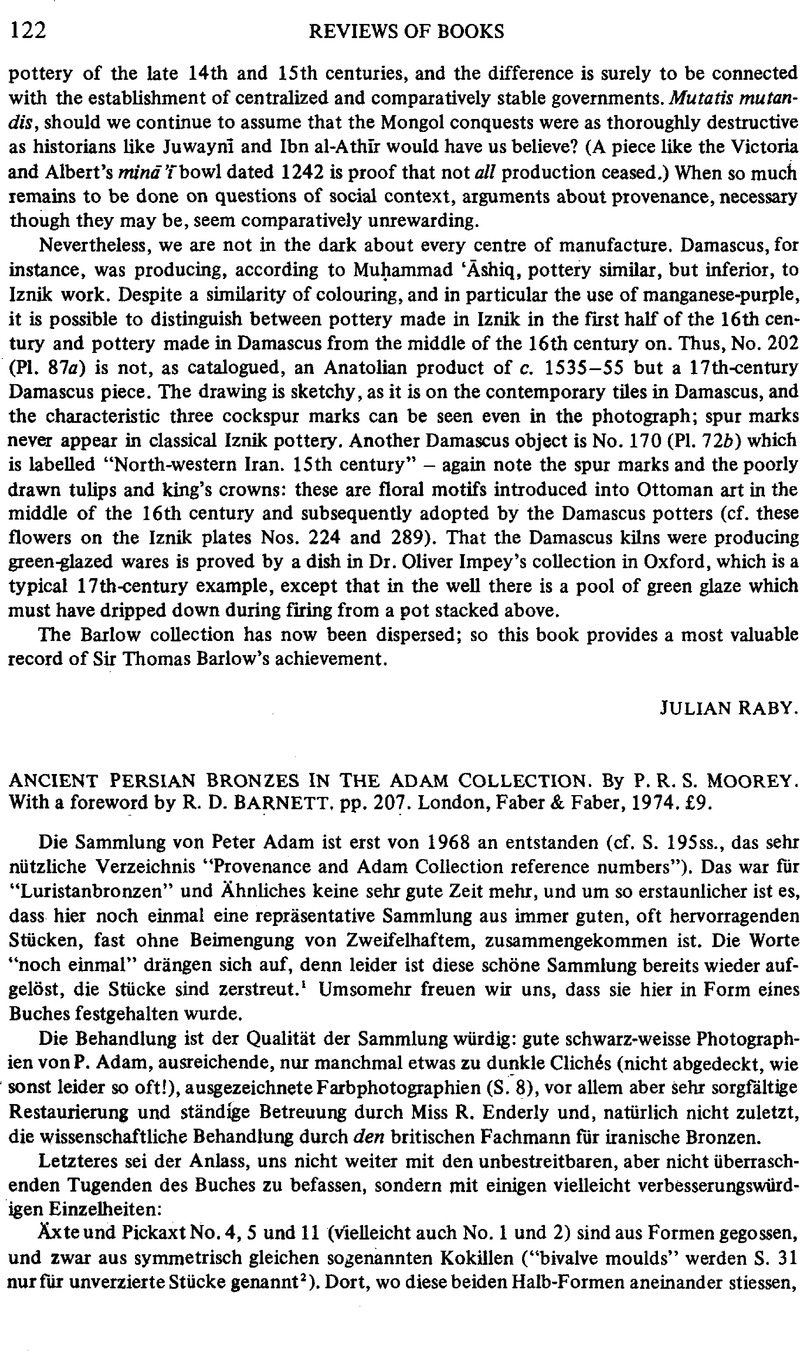No CrossRef data available.
Article contents
Ancient Persian Bronzes in the Adam Collection. By P. R. S. Moorey. With a foreword by R. D. Barnett. pp. 207. London, Faber & Faber, 1974. £9.
Review products
Published online by Cambridge University Press: 15 March 2011
Abstract

- Type
- Reviews of Books
- Information
- Copyright
- Copyright © The Royal Asiatic Society 1977
References
1 Catalogue of ancient Iranian bronzes and silver formerly in the Peter Adam Collection (Sotheby's, London, 10th 11 1975)Google Scholar. Dieser Verkaufskatalog enthält einige nützliche Abbildungen von anderen Blickpunkten als bei Moorey.
2 Moorey, Ebenso P. R. S., Catalogue of the ancient Persian bronzes in the Ashmolean Museum (Oxford, 1971), 293, nur für spätere, unverzierte Waffen.Google Scholar
3 Ich hoffe, diese Technik demnächst an einigen ausgezeichneten Stücken erläutern zu können. Vgl. Calmeyer, vorläufig P., Datierbare Bronzen aus Luristan und Kirmanshah (1969), 154, 186.Google Scholar
4 Vgl. S. 117 Anm. 1 nach einer blossen Inhaltsangabe des Nicht-Publikators: “Levels of the eighth and seventh centuries B.C.” Auch was an Scheibenkopfnadeln dorther kommen soll (Kantor, H., JNES, V, 1946, 234 Anm. 3Google Scholar; JNES, VI, 1947, 258Google Scholar; E. Porada, Art of ancient Iran (1965), 87, Abb. 59) scheint mir wesentlich älter zu sein, ebenso getriebene Blechfragmente, die ich in Chicago sehen durfte und Rollsiegel, die in Philadelphia und Teheran ausgestellt sind. So ist es doch wohl methodisch richtiger, nach unseren sonstigen Kenntnissen das Material aus Dum Surkh (oder Surkh-i Dum-i Luri) zu datieren, als auf Grund dieser Chimaira Scheibenkopfnadeln und Köcherbleche generall für 8./7. Jh. zu halten (wie es P. R. S. Moorey jetzt inlran, XIII, 1975, 119ss. seinen eigenen Vergleichen zum Trotz tut).
5 Vgl. die Stele des Untaš-GAL.
6 Besser sichtbar: Sotheby's, 21, No. 42.
7 Vgl. demnächst Calmeyer in IVth Annual Symposium on Archaeological Research in Iran (Teheran, 1976).
8 Vgl. Detail: Calmeyer, P., Reliefbronzen in babylonischem Stil (1973), Taf. 7, 6, S. 94s., Abb. 90.Google Scholar
9 z.B. Beran, ZA, LII, N.F.18, 1957, 144s., Abb. 2 (Sigel des Eriba Adad I.).
10 Demnächst Calmeyer, Archäologische Mitteilungen aus Iran, N.F. IX, 1976.
11 Reallexikon der Assyriologie, IV, 1972, 66, s.v. “Hamadan”.
12 Negahban, E. O., A preliminary report on Marlik excavation (Teheran, 1964), Abb. 113, PI. IV. Die “Life story of a mountain goat” (S. 54) muss umbenannt werden, etwa in: “Szenen von Tod und Leben”, denn im obersten Register sind offenbar Gazellen dargestellt.Google Scholar


